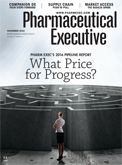Think Globally, Act Locally
Pharmaceutical Executive
The best approach to getting global brand campaigns to work all over the world
There is a paradox at play in the world of global marketing. We live in an age where the expectation is that messages can be shared instantaneously across the boundaries of time, language, and location. We are more connected than we have ever been, yet we still are not a unified world. What motivates us, what inspires us, and what drives a brand to succeed is vastly different between continents and cultures. Yet we talk about “globalization” as if that undertaking is possible in a meaningful way with our physicians and patients around the world. The goal in marketing global brands is to seek the highest common denominator in verbiage that can resonate with targets despite their location or culture. So as we begin to think about global launches, we focus on our message, the mix of media, and the journey of decision-making as expected.
What has changed is the speed and tolerance of what the world is willing to wait for. We now have the capacity with the click of a button to disseminate our message all over the world, instantaneously. But as marketers, we know the path from globalization to localization is an important one, in which steps can’t be skipped. So what are the keys to getting a global message to become a local message in today’s digital world?
Position the brand so it addresses a global unmet need in a local way
Global marketers are challenged by this every day-how to make a single item or molecule own the same position in markets that have vastly different landscapes. For some, the first reaction is to retrench into the boundaries of their role-“it’s my job to be consistent and create a single great campaign, and it is the local team’s job to adapt.” To some extent, this is true, as the global marketer is the owner and champion of the brand. However, when we expect the local teams to take our carefully crafted, often Western-oriented, English-centric position and deliver it as a relevant local position, we often see things start to unravel.
A common blind spot for global marketers, especially those new to the global role, is to focus on the product, competitors, and the message itself and not on the environment (government or payers) in the markets they are serving. For example, a product may be best in its class and it treats a condition better than any other alternatives. The manufacturer

has spent a significant amount of its launch budget on positioning, testing, and creating a killer campaign. The company sends this campaign and related assets to its regional or country affiliates. Brand teams test the campaign and make adjustments to it based on feedback.
The response the manufacturer gets, however, is disappointing. It turns out that the campaign it just finished is seen by some regions as a cure to a disease not considered debilitating enough to warrant advanced intervention. The doctors agreed that it would be a "nice to have," but they don’t need it, and, furthermore, their governments won’t pay for it. For example, in surgical ophthalmology, there are differing opinions on how astigmatism should be treated around the world. For some markets, treating the problem surgically is the answer and for others, they rely on glasses. Although a surgical approach may yield best patient outcomes, not every market sees the “need” the same way. Often, a manufacturer is not simply changing techniques, but is asking to change mindset-which is, of course, a much greater challenge. So how to avoid?
Get buy-in-early and often-from affiliates around the world
Strong global marketers know this, and it is a natural part of their process. Sadly, it is still not the norm for most companies. For many multinational companies, the global marketer is expected to deliver within the timelines of the launch project and accelerate everywhere possible. Eliminating additional rounds of positioning feedback can shorten a project cycle significantly but does so at significant risk. It takes a courageous project manager (PM) to hold up a project or delay a milestone date in order to get sufficient affiliate feedback. But if the reasoning is unimpeachable and the benefits made clear, the PM may be creating a short-term pain for a long-term gain. A few weeks of delay and a great launch trump a rushed launch and months of delayed revenue, every time.
A deep understanding of a company's strategic markets and launch schedule will create the guardrails of its affiliate feedback plan. It is important to clearly outline decision points within the project plan where feedback is critical. From there, determine which feedback needs to be weighted more. Which country launches first? How quickly will the brand launch in the next country or cluster? Which positioning will provide the biggest return in these countries? Is the manufacturer the first everywhere, or is it jumping into some highly competitive markets? The positioning should match the best overall return potential but can also evolve over time. Some marketers will balk at this, but we have all done it-whether it’s called “evergreening” or “market realignment,” very few products live their entire lifecycle with a single position.
A positioning that hits the mark for Germany may not be right for Japan. However, since many products are not launched in Japan until several years after introduction in the European Union (EU), will that time allow for a change in positioning globally? Or should a company consider multiple positions to satisfy these important markets? This used to be marketing heresy, but even the staunchest objectors admit that being “global” now really just means being more local, more often.
How can a brand team accomplish this, however, without sacrificing speed to market? Regular live discussions are a good start, but the nature of global positions is that a brand will rarely be in one place the entire year. We have to utilize technology to efficiently deliver materials for review across time zones, and be well-prepared prior to those live discussions taking place. A centralized means of sharing ideas and assets that can be quickly vetted through local legal and regulatory teams will also increase a marketer's potential for high-speed reviews and feedback sessions.
Develop a digital tool that enables global-to-local with a few clicks
The ongoing challenge global teams face beyond the boundaries of time, location, and language is asset management. Most companies develop global campaigns and then distribute them, with fingers crossed, through their global affiliates. But often, some places in the world need to either 1) localize the message to their targets or 2) translate, rethink, or even reimagine some of the materials they need to be successful in their market.
We often see companies create beautiful, integrated campaigns that are well-received in US markets, but then are rarely used outside the US. It is not that the agency and brand teams failed, but rather didn’t give each market the freedom to adjust the messages and tactics based on their needs in a cost-effective and quick way. So they sit, unused, on e-brand websites.
To solve this, companies are developing digital asset managers that will allow every user with a “seat” around the world gain access to assets and be able to customize them in real time. We have even found a way to connect the development of customized assets that can be regulatory/legal/medical reviewed at the local level, after they have been reviewed at the corporate level. Even better, these tools can be translated in the market, and the region can own the “big idea” the campaign worked so hard to achieve but still be able to localize and build a version of a sales aid or digital tool based on the needs of their targets, regardless of where they are. This saves time and money and enables a product to maintain the integrity of the global brand position, but allows regions and market to execute on a local level.
In order to globalize a brand, the manufacturer must have a message that is consistent and meaningful. It needs to find a way to position the brand so that it is important but not isolating. Marketers should talk to their global affiliates and ask for their input. But most importantly, find a way to get its hard-earned message to the world in a way they will use it. So many global campaigns are like custom homes that no one ever lives in-they are built for all but used by so few. Using a collaborative approach to developing a brand message and then launching it in a way that enables rapid localization can help ensure that your beautiful house has its share of visitors who come back often and stay a while.

Eric Bernabei is Global Product Director at Alcon, a Novartis Company. He can be reached at eric.bernabei@alcon.com.

Nancy Beesley is CMO and Partner at HCB Health. She can be reached at nancy.beesley@hcbhealth.com.

The Misinformation Maze: Navigating Public Health in the Digital Age
March 11th 2025Jennifer Butler, chief commercial officer of Pleio, discusses misinformation's threat to public health, where patients are turning for trustworthy health information, the industry's pivot to peer-to-patient strategies to educate patients, and more.
Navigating Distrust: Pharma in the Age of Social Media
February 18th 2025Ian Baer, Founder and CEO of Sooth, discusses how the growing distrust in social media will impact industry marketing strategies and the relationships between pharmaceutical companies and the patients they aim to serve. He also explains dark social, how to combat misinformation, closing the trust gap, and more.